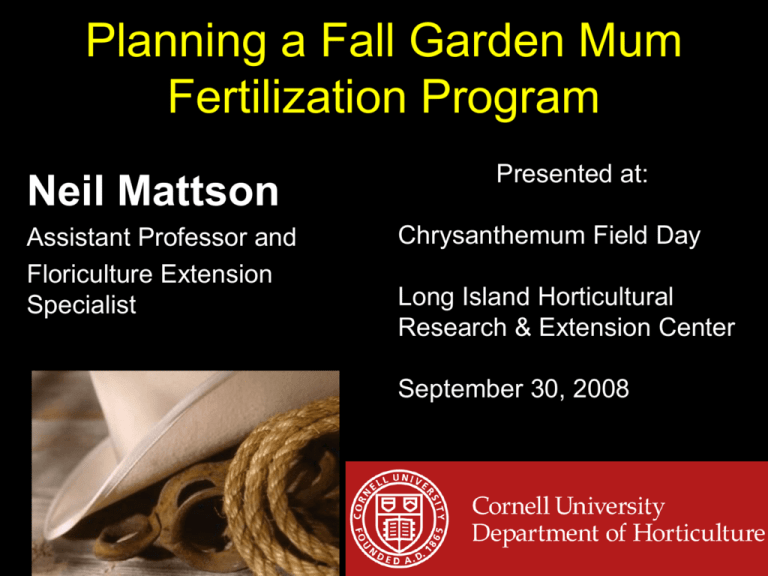Greenhouse, Field Grown Nursery Pl
advertisement

Planning a Fall Garden Mum Fertilization Program Neil Mattson Assistant Professor and Floriculture Extension Specialist Presented at: Chrysanthemum Field Day Long Island Horticultural Research & Extension Center September 30, 2008 The Good Fertilize to match plant growth Finish 1.0 Relative plant biomass Rapid Vegetative Growth 0.8 0.6 0.4 Transplant 0.2 0.0 0.0 0.2 0.4 0.6 Relative time 0.8 1.0 The Plan – Constant Liquid Feed • Initially – 200-300 ppm N with 20-10-20, 20-20-20 or 15-5-15, etc. – High side for mixes with bark – less than 200 ppm N if controlled release fertilizers are also used • Once plants are actively growing: – Rotate in 15-0-15 every third watering – Helps to control stretch The Plan – Constant Liquid Feed • Once buds appear: – Use 15-0-15 continuously • Pea-sized buds: – Clear water only More thoughts… • Following rainy weather– give them a boost • Reduce feeding during extreme heat when plant growth shuts down • Push vegetative growth immediately following transplanting/cool weather – fertilize well to avoid premature budding Controlled Release Fertilizers Temperature controls rate of release Product longevity (months) 10 3-4 month 5-6 month 8-9 month 8 6 4 2 0 60 70 80 Average temperature (°F) 90 Using Controlled Release Fertilizers for Mums • Less control – initial may not be enough – can’t slow-down release at the end • Top dressing/incorporated at medium-high rate – 14-14-14, 15-9-12, etc. • Distribute evenly so one spot doesn’t get burnt; make sure prills are moistened at each watering • Make sure micros are included when using a soilless mix • If using incorporated CRFs - use within one week of mixing; otherwise salts can accumulate and can burn roots Other Considerations • During cold temps may need to supplement with liquid feed to push vegetative growth • 3-4 month formulations can run out early (high temps) Chrysanthemum CRF/WSF Experiment Cultivar ‘Coparo’ CRF Only 2 wks WSF 4 wks WSF CRF + WSF Osmocote Plus 8-9 Month 6 wks WSF Control: Liquid Feed Only Source: Mark Bridgen Combination of CRFs with a Liquid Feed Program • Research by Dr. Mark Bridgen • CRF only plants (with an 8-9 month product) were not as large as constant liquid feed plants • However using liquid feed for the first 4-6 weeks then only media incorporated CRF gave growth nearly as large as constant liquid feed plants control High Med Low High Osmocote Plus 3-4 month Med Low High Med Low Osmocote Plus 5-6 month Osmocote Plus 8-9 month Research by Dr. Mark Bridgen • Testing 3 different rates of media incorporated CRF (Low, Medium, High) • And 3 different release periods (3-4, 5-6, and 8-9 month) • Using the High rates suitable plant size was found CRF Recommendations • You CAN grow a mum with 100% Controlled Release Fertilizer. • Use higher rates: 10-14#/cu.yd – ie, 28-39 g/9”pot • Or use a lower rate, if a smaller plant form is desired ‘Sparkle White’ • Use the 8-9 month formulation • If your mums are looking yellow at the end, hit them with a liquid feed about 10 days before sale. Source: Mark Bridgen Are you on track? • Periodic pH and EC (salt) monitoring is recommended • pH: 5.5-6.4 • EC (dS/m) – Establishing – Transplant/Vegetative – Finishing SME 0.8-1.5 1.7-3.0 0.8-1.5 PourThru 1.0-2.0 2.3-4.0 1.0-2.0 Of Note: • Avoid water stress – can reduce flower size and delay flowering • Low fertility can cause poor plant size and buds not developing on schedule • High fertility can cause root tip burn and delay flowering The Bad Low Fertility Low Fertility - P The Ugly Guidelines for foliar analysis values for Chrysanthemums Samples from the top-most fully expanded leaves Nitrogen (N) Phosphorus (P) Potassium (K) Calcium (Ca) Magnesium (Mg) Boron (B) Copper (Cu) Iron (Fe) Manganese (Mn) Zinc (Zn) 4.0 – 6.5 % 0.25 – 1.0 % 3.5 – 6.5 % 0.5 – 2.0 % 0.3 – 0.6 % 25 – 100 ppm 5 – 50 ppm 50 – 300 ppm 30 – 350 ppm 15 – 50 ppm Source: Plant Analysis Handbook for Georgia, 1988 Iron Chlorosis Correcting Iron Chlorosis • A problem at high substrate pH which causes iron to be poorly soluble – correct Substrate pH – nitrogen form (ammonium decreases pH) – acid injection • Drench with Iron chelate – Solubility depends on pH • Iron-EDDHA > DTPA > EDTA > Iron Sulfate • Foliar spray of Iron – Watch out for phytotoxicity! – wash foliage soon after applying Magnesium deficiency • 20-10-20, 20-20-20 15-0-15 have very little Magnesium • A problem at low pH (Mg unavailable) and not present in water source/fertilizer • Typically a problem when alkalinity is low – not present in the tap water – low alkalinity low pH • Supplement with epsom salts (Magnesium sulfate) – Continuous – Every month Pythium induced nutrient deficiency Pythium Healthy Pythium Healthy Questions? Neil Mattson nsm47@cornell.edu Online: http://www.greenhouse.cornell.edu Please Note – Trade names used in the presentation are for convenience only. No endorsement of products is intended, nor is criticism of unnamed products implied.






